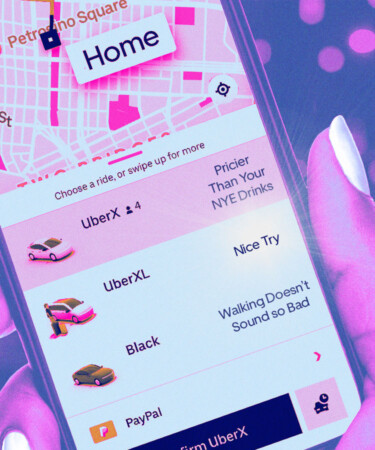It’s an all-too-familiar struggle during the holiday season. As the party winds down in the wee morning hours, you find yourself tapping your favorite rideshare app for a ride home. As you wait for a car among a group of other revelers, you look at the price estimate in utter shock. While you might have anticipated a heavy transit bill after a night out, you didn’t anticipate paying this much.
Surge pricing — the program that Uber and some of its competitors utilize when there are too many ride requests and not enough drivers — can result in exponentially higher fares. It’s a common annoyance among riders, but one that may feel difficult to avoid.
There are myriad reasons why a ride home might include surge pricing. During weekday a.m. and p.m. rush hours, you’re almost certain to experience higher pricing. Bad weather means more ride requests, which in turn causes price hikes. Uber defines surge pricing as a “premium” for riders to receive quicker service and an incentive for drivers to pick up a shift.
While the final bill might vary based on the location, time, and ride demand, Uber’s service fees do not change based on surge pricing. Lyft is less transparent about its prime-time pricing algorithm, but it’s assumed that the two services operate in similar ways.
If you’re not looking to shell out major cash on a ride this New Year’s Eve, here are six ways to save on your trip home.
- Take a Walk: Surge pricing often depends on the location from which you’re hailing a ride. If you’re among a crowd of other partygoers trying to call an Uber from the bar, your ride may cost more than expected. For drivers, a color-coded map on the Uber app identifies high-traffic areas where users are more likely to pay premiums. Stroll down a few blocks and try again — it might just be the difference between an affordable fare and a budget-breaking one.
- Wait It Out: This is possibly the most common sense option, but it does actually help in alleviating inflated pricing. You could start by checking Uber pricing while still at the venue: When you spot a good deal, hail a ride and call for the check. While you’re at it, sip a glass of water or two — your future self will thank you.
- Study the Numbers: If you’re really on a tight budget, it’s best to plan around the busiest times. On New Year’s Eve, one of the busiest nights for rideshare services, users might notice their typical fare double or even triple. Uber estimates that peak ridership happens between 12 a.m. and 3 a.m. on the holiday. Either plan to leave the party early, or keep it rocking until the next morning.
- Schedule Ahead: For those with a clear plan for how their night will end up (i.e., the location they’ll need to be picked up), it’s helpful to schedule a ride ahead of time. These rides are given priority over others and are based on static pricing, meaning that you’ll avoid any surge rates. To avoid pricing changes, Uber recommends scheduling the ride at least one hour before departure. The downside? If your friend invites you to the after after party, you’re stuck declining or facing a cancellation fee. Plus, you’ll be charged a set reservation fee, which might range from $8 to $12.
- Commit to a Subscription: If you use rideshare services several times a week, this might be a smart investment. Uber One and Lyft Pink subscriptions give users access to quicker and discounted rides, which might make up for some of the surge fees. Lyft Pink also promises subscribers faster pickup times.
- Go Old School: When none of these options work, opt for a ride in a classic yellow taxi. In many large cities, riders can call a number to request a taxi or hail it the old-fashioned way. Curb, an app similar to ridesharing platforms, also allows users to manage their taxi rides from their phones. While this mode of transit might still include some form of congestion pricing, it likely won’t be as extreme as Uber’s. Of course, public transportation — if it’s available in your zip code — is always an affordable option, too.
